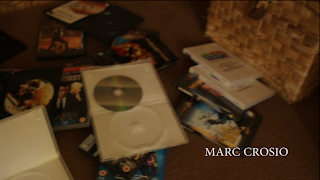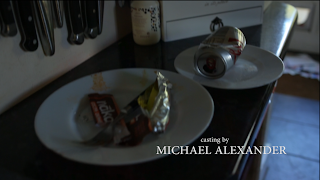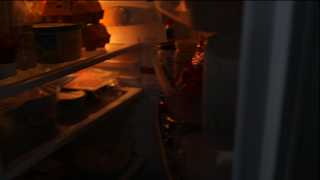 We achieved this by using mise-en-scene as one of the main component by showing the house as being really messy and not being well taken care of. We did this by firstly putting a pile of unopened mails in the front step, representing the age of a teenager as not being very responsible as well as the gender of male to be more untidy. The mails also created tension and gives the audience hints of time passing as there are many mails from different date throughout the week which haven't been looked at which suggests to the audience that he is unable to check the mail. The cereal bowl shows that he as a teenager leaves stuff around the house in addition to the tobacco being spread onto the picture shows a negative stereotype of teenager being rebel and unresponsible. The dirty uncleaned dishes in the sink and the left-opened fridge represents the age and gender of him not being very hygienic which is a negative stereotype of young men. The shoes being left around in the house shows negative representation of him as being untidy which meets the expectation of a normal typical teenage boy. The picture frames around the house shows the mise-en-scene of a normal happy middle class family. This is a positive stereotype of a family as it shows them as being close since a long time ago which shows that there was no divorce or separation in the family. There were also childhood pictures which shows that the family has quite a strong bond in between them. The pots of paint around the house shows the house as being renovated. This is a stereotype of men as men tends to do all the labour tasks in the family while women does other things. The final murder scene shows the body wearing a low-waisted tight jeans with boxers which is a stereotype of young teenage boy.
We achieved this by using mise-en-scene as one of the main component by showing the house as being really messy and not being well taken care of. We did this by firstly putting a pile of unopened mails in the front step, representing the age of a teenager as not being very responsible as well as the gender of male to be more untidy. The mails also created tension and gives the audience hints of time passing as there are many mails from different date throughout the week which haven't been looked at which suggests to the audience that he is unable to check the mail. The cereal bowl shows that he as a teenager leaves stuff around the house in addition to the tobacco being spread onto the picture shows a negative stereotype of teenager being rebel and unresponsible. The dirty uncleaned dishes in the sink and the left-opened fridge represents the age and gender of him not being very hygienic which is a negative stereotype of young men. The shoes being left around in the house shows negative representation of him as being untidy which meets the expectation of a normal typical teenage boy. The picture frames around the house shows the mise-en-scene of a normal happy middle class family. This is a positive stereotype of a family as it shows them as being close since a long time ago which shows that there was no divorce or separation in the family. There were also childhood pictures which shows that the family has quite a strong bond in between them. The pots of paint around the house shows the house as being renovated. This is a stereotype of men as men tends to do all the labour tasks in the family while women does other things. The final murder scene shows the body wearing a low-waisted tight jeans with boxers which is a stereotype of young teenage boy. 
 We used sound to represent the age and gender in this opening sequence by adding answerphone messages from his family members and girlfriend as well as the dentist appointment. The first message was from an operator at a dentist which is a girl. This is a stereotype as most of the operators for big companies are usually female as they have softer and more manipulative voice. The second message was from the character’s mother telling him to look after the house and not have any party. This is a positive stereotype of age and gender as the mother is usually very protective over the children and very uptight. The fact that she told him not to have any party suggests that the character likes to party a lot and getting drunk which is a negative stereotype of young male. The first message from the girlfriend was a negative stereotype of young teenage girl as it shows her being clingy and very over-protective. It also shows the stereotype of women having to call the men which suggests men as being higher in status which is a stereotype. The fact that he missed the date with her shows a negative stereotype of men being less responsible as he forgot the date. The message from the dad shows a stereotype of male being more laid back than the women. The fact that the mom was worried shows a negative representation of women as overthinking a lot while the dad is more chilled out. The last message from the girlfriend gave a negative representation of a teenage girl as she was getting mad and overthinking that he liked someone else which is a stereotype of women to be very sensitive about their partner cheating which leads to overthinking, suggesting that she is the overly-attached type of girlfriend.
We used sound to represent the age and gender in this opening sequence by adding answerphone messages from his family members and girlfriend as well as the dentist appointment. The first message was from an operator at a dentist which is a girl. This is a stereotype as most of the operators for big companies are usually female as they have softer and more manipulative voice. The second message was from the character’s mother telling him to look after the house and not have any party. This is a positive stereotype of age and gender as the mother is usually very protective over the children and very uptight. The fact that she told him not to have any party suggests that the character likes to party a lot and getting drunk which is a negative stereotype of young male. The first message from the girlfriend was a negative stereotype of young teenage girl as it shows her being clingy and very over-protective. It also shows the stereotype of women having to call the men which suggests men as being higher in status which is a stereotype. The fact that he missed the date with her shows a negative stereotype of men being less responsible as he forgot the date. The message from the dad shows a stereotype of male being more laid back than the women. The fact that the mom was worried shows a negative representation of women as overthinking a lot while the dad is more chilled out. The last message from the girlfriend gave a negative representation of a teenage girl as she was getting mad and overthinking that he liked someone else which is a stereotype of women to be very sensitive about their partner cheating which leads to overthinking, suggesting that she is the overly-attached type of girlfriend. In the editing section, we decided to minimise editing as much as possible therefore the audience can focus more on the objects around the house as well as the answerphone messages. We tried to stabilise the footage using warp-stabiliser to remove the handheld motion of the shot but in the end we decided that it would look better with the handheld effect as it represents the stereotype of teenager being more active rather than middle-aged business man which is more responsible and consistent which then we would have used the stabiliser to create the ‘consistent’ effect. On the last scene of the murder, we decided to slowly zoom-out from the birds-eye-view shot of the dead body to show clearer settings of how the body is gushed with blood, representing the stereotype of age and gender of teenager boy being more violent.
In the editing section, we decided to minimise editing as much as possible therefore the audience can focus more on the objects around the house as well as the answerphone messages. We tried to stabilise the footage using warp-stabiliser to remove the handheld motion of the shot but in the end we decided that it would look better with the handheld effect as it represents the stereotype of teenager being more active rather than middle-aged business man which is more responsible and consistent which then we would have used the stabiliser to create the ‘consistent’ effect. On the last scene of the murder, we decided to slowly zoom-out from the birds-eye-view shot of the dead body to show clearer settings of how the body is gushed with blood, representing the stereotype of age and gender of teenager boy being more violent.
For camera angles, we came to a conclusion to use a one-shot take throughout the whole establishing shot of the opening sequence. This is to show the mise-en-scene of the house without the audience being interrupted by cuts to represent the negative stereotype of a young teenage boy being really messy and untidy. The last shot of the birds-eye-view of the dead body represents the character as being over-powered and having less power in society as the shot is looking down towards the body, showing the stereotype of teenager being lower in society than the working age, giving a negative representation to the character.


No comments:
Post a Comment